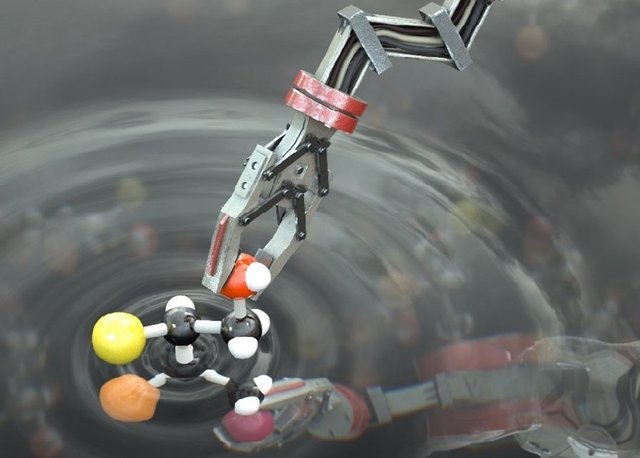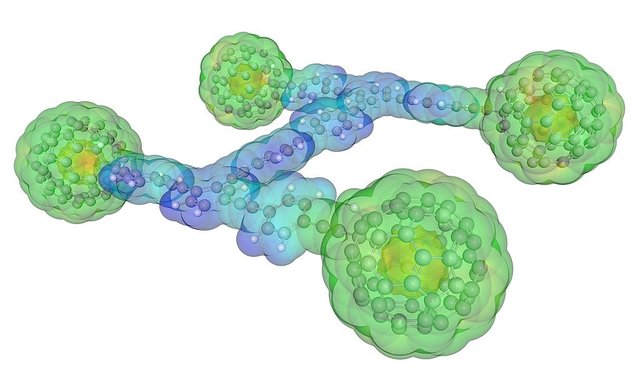
Nanotechnology has been improving by leaps and bounds in the past decade and scientists have now found a way to create a molecular robot.
The new and growing branch of nanotechnology promises much. In the near future, experts predict that nanosensors will be used inside our bodies to monitor our health and alert us of disease or even an oncoming health crisis. Nanosensors could also monitor the environment. Another exciting application is creating the next generation of materials with novel properties.
Sensors are the first step in an ever more ambitious process of merging man with machine. Beyond that nanobots will be capable of making instant repairs based on the information provided from nanosensors.
Consider self-healing materials. Tear your jacket. No problem. It just grows back. In the realm of energy, nanotech could be used to improve solar cells and develop ultra-capacitors for energy storage, which could help us embrace green energy and jettison fossil fuels. In total, scientists believe nanotech can help us to develop multi-component systems that are smart, autonomous, and adapt to the environment or changing circumstances.
It wasn't until just recently that a research team at the University of Manchester in the UK reached another milestone. They’ve developed a robot that operates on the molecular level. The world’s first molecular robot has an arm which can manipulate individual molecules or move them in clusters. This is an amazing leap in what was previously only a field considered in science fiction.
The thing is a millionth of a millimeter in size. To give you an idea of the scale we’re talking about, one quintillion (a billion billion) of them piled together would be about equal to a few grains of salt. Each machine is comprised of 150 atoms. That includes carbon, hydrogen, oxygen, and nitrogen atoms. Though small, these machines could offer us incredible capabilities, such as to work in tiny, molecular factories, in order to manufacture the next generation of materials and products.

Nanocar created at Rice University. Edumol, Molecular Visualizations. Wikimedia Commons.
Techblogger Wrap Up
Its hard to believe we are now living in an age which promises advancements in nanosensors, nanobots and nanofibre material. They have now finished prototypes of the first molecular nanobot and beyond that it actually can be made to perform the function of gathering multiple molecules together. How much longer will we have to wait until nanobots are a regular part of health and wellness therapy. How many applications will be found for them?
Please leave comments and feedback below!
Thanks for reading.
Source:
The World’s 1st Molecular Robot Has Just Been Created by UK Scientists - Big Think
@techblogger, Your contributions to our common cause have enabled me to help you with this up-vote! I very well remember that you started feeding me 5 days ago. Together, we both become stronger every day.
Your’s Spinny
Join my Discord server if you want to meet others: https://discord.gg/Mz2EZP3
Downvoting a post can decrease pending rewards and make it less visible. Common reasons:
Submit
In the future such robots could be used for medical purposes, advanced manufacturing processes and even building molecular factories and assembly lines. The research will be published in Nature on Thursday 21st September.
Professor David Leigh, who led the research at University’s School of Chemistry, explains: ‘All matter is made up of atoms and these are the basic building blocks that form molecules. Our robot is literally a molecular robot constructed of atoms just like you can build a very simple robot out of Lego bricks. The robot then responds to a series of simple commands that are programmed with chemical inputs by a scientist.
read original article here
https://scienmag.com/scientists-create-worlds-first-molecular-robot-capable-of-building-molecules/
Downvoting a post can decrease pending rewards and make it less visible. Common reasons:
Submit
nice info about this
Downvoting a post can decrease pending rewards and make it less visible. Common reasons:
Submit
Wow! It's amazing the speed that technology is progressing (no flying cars yet, but this arguably a lot cooler and more usueful). How do they manage to program something so infinitely small?
Downvoting a post can decrease pending rewards and make it less visible. Common reasons:
Submit
hiiiii
Downvoting a post can decrease pending rewards and make it less visible. Common reasons:
Submit
Great feeds
Downvoting a post can decrease pending rewards and make it less visible. Common reasons:
Submit
Thanks for your work @techblogger Followed...
Downvoting a post can decrease pending rewards and make it less visible. Common reasons:
Submit